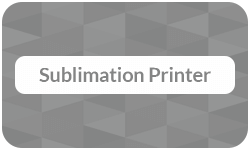
Printers come in various types, each one designed to serve different purposes and technologies, such as inkjet and mobile printers. While some are used for general document printing, sublimation printers are specialized types of printers that cater to durable image transfer on various materials. In this article, we’ll focus on what they can do, how they do it, and advantages and disadvantages of buying them.
Definition: Sublimation printer
A sublimation printer is a specialized printing device that uses heat and pressure to transfer dye onto materials such as fabric, ceramics, and plastics. This printer uses a process called dye sublimation, where solid dye converts directly into gas without passing through a liquid phase. This process is commonly used in industries like apparel, promotional products, and customized gifts since they use excellent color accuracy and durability.
Unlike traditional printers like inkjet printers that apply liquid, opaque printing ink directly onto a surface, sublimation printers use transparent sublimation ink, which means they cannot print white. Instead, the white areas in a design are actually the color of the material underneath. Because of this, sublimation works best on white or light-colored fabrics.
Your guide to print and production
- Information on print finishing & print processing
- Information on materials & optimal use of materials
- Information on printing processes & print production
Learn more!
How does sublimation work
You need six things when it comes to sublimation printing: sublimation ink, your digital design file, sublimation transfer paper, a sublimation printer, a heat press machine, and of course, the material you want to print your design on.

The first step of sublimation printing is creating and preparing your digital file. This involves mirroring your design since it will be transferred face-down onto your desired material. You can create or edit your digital design file with graphic design software, such as Adobe Photoshop, Illustrator, or free tools like Canva. Plenty of printers come with software that allows you to flip your image horizontally in the printer settings.

Step two involves using a sublimation printer loaded with sublimation ink (special liquid dye-based ink) to print your design onto sublimation transfer paper. Sublimation ink follows the standard CMYK color system to improve color accuracy, while the paper is specially coated to hold the ink and release it during the heat transfer process. In its storage form, the sublimation ink is a liquid that dries on the transfer paper and thus becomes a solid.

The printed transfer paper is then placed on the material you want to print it on, e.g., a polymer-coated mug. The printed paper and material are then put together in a heat press machine with the paper placed on top of the material.

The heat press applies high temperature and pressure for a set amount of time depending on the material. The heat causes the solid dye on the transfer paper to sublimate, turning from solid directly into gas. This gas then penetrates the fibers or surface coating of the material, which embeds the image permanently.

When the heat press cycle finishes, the transfer paper is removed, which reveals a vibrant print (thanks to the CMYK color system) that won’t crack, fade, or peel easily because the dye has become part of the material itself.
Materials to sublimate on
Sublimation printing works best on polyester fabrics or materials that are coated with a polymer layer and have a smooth surface. If your material doesn’t have any of these criteria, you can add a special polymer coating to its surface, e.g., by using sublimation coating for wood and stone or using a sublimation spray after cleaning your material’s surface. Don’t forget to cure the coating using heat. Common items to print on are:
- Aluminum or metal sheets
- Blankets
- Bookmarks
- Business cards
- Ceramic mugs & tiles
- Cutting boards
- Jewelry
- Keychains
- License plates
- Magnets
- Mouse pads
- Notebooks
- Phone cases
- Pillow covers
- Polyester textiles (t-shirts, sportswear, flags)
- Puzzles
- Tote bags
- Towels
- Trucker hats
- Tumblers
Heat press settings
Getting the right heat press settings is essential for successful sublimation transfers. Settings may vary depending on the material and heating press, but here are some general examples to help you get started:
| Material | Max. temp. | Time | Pressure |
|---|---|---|---|
| Aluminum | 400 °F / 204 °C | 45-60 sec | Medium |
| Ceramic mugs | 400 °F / 204 °C | 150-300 sec | Medium-high |
| Fabric | 400 °F / 204 °C | 45 sec | Medium |
| Glass | 400 °F / 204 °C | 180-300 sec | Medium |
| Hats | 350 °F / 180 °C | 60 sec | Medium |
| Marble | 400 °F / 204 °C | 120 sec | Medium-high |
| Metal | 400 °F / 204 °C | 60 sec | Medium-high |
| Puzzles | 350 °F / 180 °C | 60 sec | Medium |
| Tumblers | 385 °F / 196 °C | 75-120 sec | Medium-high |
| Wood | 400 °F / 204 °C | 60-70 sec | Medium-high |
Note: Always refer to the manufacturer’s guidelines for specific substrates, as coatings and finishes can affect optimal settings.
Heat press or iron
Sublimation printing can be quite expensive since you need to buy a sublimation printer, sublimation ink, and a heat press. However, if you’re only making a couple of shirts a month, a simple iron can go a long way for small projects. That said, a heat press is often worth the investment since you can easily control the heat, cover larger surface areas evenly, and apply consistent pressure.
If you’re exploring other custom apparel methods, you might also consider heat transfer vinyl (HTV), which uses a similar heat press process but involves cutting and pressing vinyl designs onto fabric instead of dye sublimation. This method, however, can crack and peel over time since the vinyl lies on top of the material’s surface.
Nevertheless, if you want to invest in a heat press, be on the lookout for bundles, discounts, and popular brands like HTVRONT and Cricut, which offer reliable options for both sublimation and HTV projects.
Printing services at BachelorPrint
- Wide range of print products for every need
- Individual solutions & personal support
- High print quality & fast production times
Learn more!
Benefits & disadvantages
Below, you can find pros and cons when it comes to sublimation printers.
Pros
- Same-day production
- Don’t crack, fade, or peel easily
- Wide range of compatible products
- Vivid images with smooth gradients
- Environmentally safer than other inks
- Soft feel on fabrics due to dye sublimation
Cons
- Can’t print white
- Ink is UV-sensitive
- Expensive initial cost
- Typically requires heat press
- Ineffective on dark fabrics & materials
- Fabrics have to be made of 100% polyester
Sublimation without a printer
If you would rather not buy a sublimation printer but already have an iron or a heat press, there are still ways to create sublimation designs. One option is to purchase custom or pre-printed sublimation transfer papers. Another creative option is to use infusible ink pens on compatible fabric or materials. You can simply draw your own designs, like colouring pages or hand-drawn artwork, onto laser copy paper since it can withstand heat. Then all you have to do now is apply heat via a heat press or iron to transfer the design onto your material.
Maintenance
When it comes to maintenance, there are some things to look out for.
- Store the ink away from direct sunlight.
- Use an airtight container, preferably the one it came in, to shop the ink.
- Wash them in cold water with a mild detergent and air-dry in a cool, dry spot.
- Maintain a temperature range of 59 to 77 °F (15 to 25 °C) to ensure the ink stays in good shape.
FAQs
You can use a sublimation printer.
A sublimation printer is a specialized type of printer that uses heat to transfer dye onto materials, such as fabric, ceramic, metal, and plastic.
Sublimation printers are used to print designs that are then transferred to objects, such as t-shirts, mugs, phone cases, and other promotional items using heat.
That depends on your needs. There are no set rules, but this type of printer doesn’t require regular maintenance unless it’s used frequently. However, the ink can dry out if left unused for long periods, so make sure to shop them properly.
If you would rather not invest in a sublimation printer or a heat press, you could explore alternatives like heat transfer vinyl (HTV) and iron-on transfers.